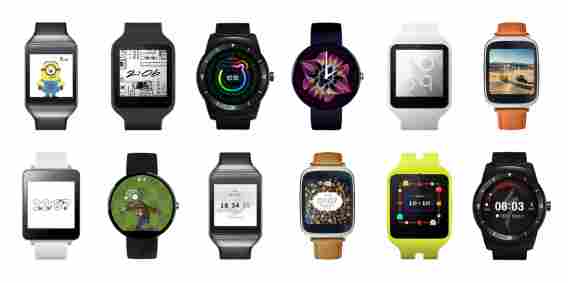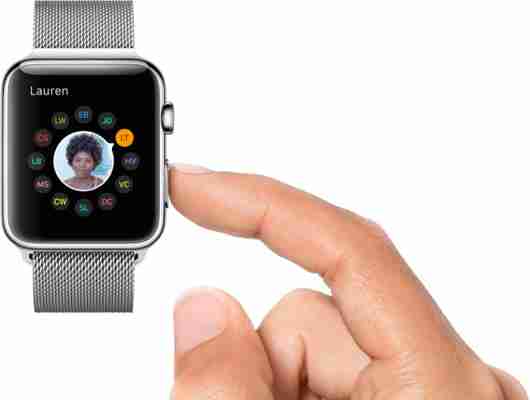Google announced Android Wear in June 2014 with the LG G Watch and Samsung Gear Live as the first available Android smartwatches. Later that year, the Motorola 360 introduced the first Android Wear watch with a round bezel. Now there are six watches in both square and round styles with varying prices.
The Apple Watch opened pre-orders at midnight April 10 and will be released April 24, 2015. There are three versions in two different sizes, 38mm and 42mm. Now both platforms finally go head to head.

Android Wear offers six different watch styles from different manufacturers, but the operating system is locked down by Google so there isn’t a difference switching from one watch to another. Each watch is platform exclusive. Connecting Android Wear to an Android phone requires Bluetooth and the Android Wear app .
The Watch OS is a new Apple operating system that will easily connect with iOS because of Apple’s closed platform. This gives Apple Watch easy connectivity because there are fewer devices it needs to connect with.
But what are the differences between Android Wear and Watch OS?
Interface
Both smartwatch platforms use touch with small differences. Android Wear is a touch-based operating system where you manipulate cards by swiping in different directions to interact or dismiss information. Tapping the screen starts actions like voice replies for messaging or controlling music.
Android Wear also supports “Ok Google” voice commands to perform actions in compatible apps. Android Wear interacts with apps on your phone and there are only a limited number of locally installed Android Wear apps.

Watch OS uses a combination of touch and physical controls. The Digital Crown on Apple Watch is used for scrolling and zooming. This is designed so your finger isn’t blocking the screen. Having the crown also helps traditional watch wearers feel at home. There’s also a side button used to access Friends or the people you contact frequently. You can send sketches drawn on the screen, send tap unique tap patterns, and your heartbeat
Touch controls are still used to interact with apps Instead of cards, Watch OS uses floating icons that you can swipe around. Apple’s Force Touch is a secondary input for additional controls. The combination of the crown and touch control could make navigation confusing for users.
Watch faces
The basic functionality of any smartwatch is to display the time. Both Android Wear and Apple Watch have this and both watches have a selection of different watch faces. Apple limits customization to the included watch faces without the option to install new ones unless they’re included in a Watch OS update.
Android Wear has stock watch faces, additional watch faces designed by manufacturers, and third party watch faces. If you don’t like the included watch faces, you can search Google Play and find a watch face that you like. Google requires that Android Watch faces meet specific guidelines so you’re getting an approved watch face.
Notifications
The common use of smartwatches is to show notifications . Regardless of what Google and Apple say about the additional features, notifications are the most common action. Both Android Wear and Apple Watch send notifications and give you the option to block notifications from specific apps .
Depending on how many apps are installed on your phone, you could be getting notifications from a bunch of useless apps. Android Wear is quick to tell you when a notification arrives and you can mute your phone when connected to Android Wear so your phone is silenced.
In theory, Apple Watch should also have this function. If you’re connected to your Apple Watch, your phone shouldn’t vibrate or play a tone and only let you know through the watch. But those first few days, you should be prepared for a lot of irrelevant notifications.
Voice Control
Android Wear uses “Ok Google” to activate voice commands. You can give simple commands like calling someone, getting directions, and finding answers to simple questions with Google Search. One great feature is “ Play Music ,” which will start your default music player. You can even specify an artist, though the results can be hit or miss.
Voice is also used to reply to messages. There is a “Reply” button on compatible apps and after tapping it, you speak your message. Android Wear will register the message and send it back. It’s great if you’re driving and need to send a quick message.
Apple Watch uses Siri , activated by saying “Hey Siri.” You can record messages, get directions, or view your events for the day. There are more commands like finding out the time.
Voice control is still a hit or miss. When it works, it’s a nice feature. But in practice, it can actually add an extra step.
Fitness
Another “big” feature for smartwatches is recording health data. Unfortunately, no one has it perfect. Some Android Wear watches can track information like daily steps, heart rate, or calories; but this information isn’t always precise.
Compatible apps link with Google Fit (Google’s health app), but collecting data might require a third party product like a FitBit . Another problem is some watches lack sensors needed for more precise information. Another issue is that these apps still need connectivity with your phone, making exercise more annoying by requiring your phone.
Apple Watch’s Health sensors monitor your heart rate and uses the accelerometer to measure movement, steps, and calories burned. When connected to your phone, Apple Watch can also use GPS for bigger workouts not tracked in steps like cycling.
But like Android Wear and Google Fit, Apple Watch and Health may only pull data from other apps into its database. And some apps require a connection to the iPhone for the data connection. This makes it difficult to go out to exercise and leave your phone at home.
Mobile payments
Both Android and Apple support NFC payments. On Android phones, you use Google Wallet to pay at participating stores. There’s no payment system built into any of the Android Wear smartwatches.
Apple is one step ahead. The iPhone 6 and iPhone 6 Plus support NFC for in-store purchases. The Apple Watch also has NFC and you don’t even need your iPhone to use it. One extra bonus is that you can use Apple Pay on the Apple Watch paired with a wider selection of iPhones including the iPhone 5, 5c, 5s, iPhone 6, and 6 Plus.
How about software?
Both Android Wear and Apple Watch have similar core features. The operating system is designed with two different perspectives. Android Wear is an extension of Google Now . It’s easy to jump from your phone to Android Wear if you use Google Now and its curated data.
Watch OS is designed as an extension of iOS. It contains a lot of similar features, like Siri, and uninstallable apps you rarely use. iOS users will be comfortable jumping into Watch OS because it has a similar design and interface. The difference is how you interact with the screen using the crown and touch controls.
But the key to each wearable is third party app support . Without apps, there’s no reason to buy a smartwatch. Most apps don’t need much updating to work with either platform. It’s the smartwatch-specific functions that make the watch usable. Communication apps are prime examples of convenience. Replying with your voice is easier than pulling your phone out to type out a message.
Social networking apps provide quick glances on what’s happening. But most people don’t need their Twitter feed on a smartwatch. This is an area where developers haven’t figured out how to properly integrate social features. A majority of the time, it’s a notification or extension of features from the phone app.
Developers are thinking about smartwatch uses
BMW and Hyundai released apps to connect Android and iOS phones to its cars. These apps extend to smartwatches, giving you the ability to remotely start the car or lock the doors. As more cars implement this technology, smartwatches could replace the car key. The launch of Android Auto and CarPlay could see growth even faster.
The connected home is also another area that companies are starting to move into. It’s not a new trend, but a trend that’s building more momentum. Philips Hue bulbs can be controlled through an app. Nest has an Android app that controls the temperature in your home. Honeywell Lyric is another thermostat controller compatible for Apple Watch. Lutron Caséta is another light control app that you can control through Apple Watch.
Another avenue is using the security built into devices to replace aging technology. SPG for Apple Watch is Starwood Hotels & Resorts’ replacement for the room key. You use Apple Watch to unlock your door .
Innovation shouldn’t be making new uses for the smartwatch, but how it can replace existing technology and make it better. The adoption of Android Wear and Apple Watch is based on an artificial need. It can’t replace your phone and acts as a bridge for information.
With Apple in the smartwatch arena, expect app development for smartwatches to increase. The company is great at pushing companies to adopt new technology much faster than Google. Since both major players are in the game, there will be more innovations and improvements.
That may be a positive and negative because like phones, you may need new hardware to take advantage of the newest features.
Related Articles
Apple Watch: everything you need to know
Everything you need to know about GTA V on PC
Best free apps for Samsung Galaxy S6
Follow me on Twitter: @chrislikesrobot